wheel YAMAHA YFM50S 2004 User Guide
[x] Cancel search | Manufacturer: YAMAHA, Model Year: 2004, Model line: YFM50S, Model: YAMAHA YFM50S 2004Pages: 350, PDF Size: 5.87 MB
Page 208 of 350
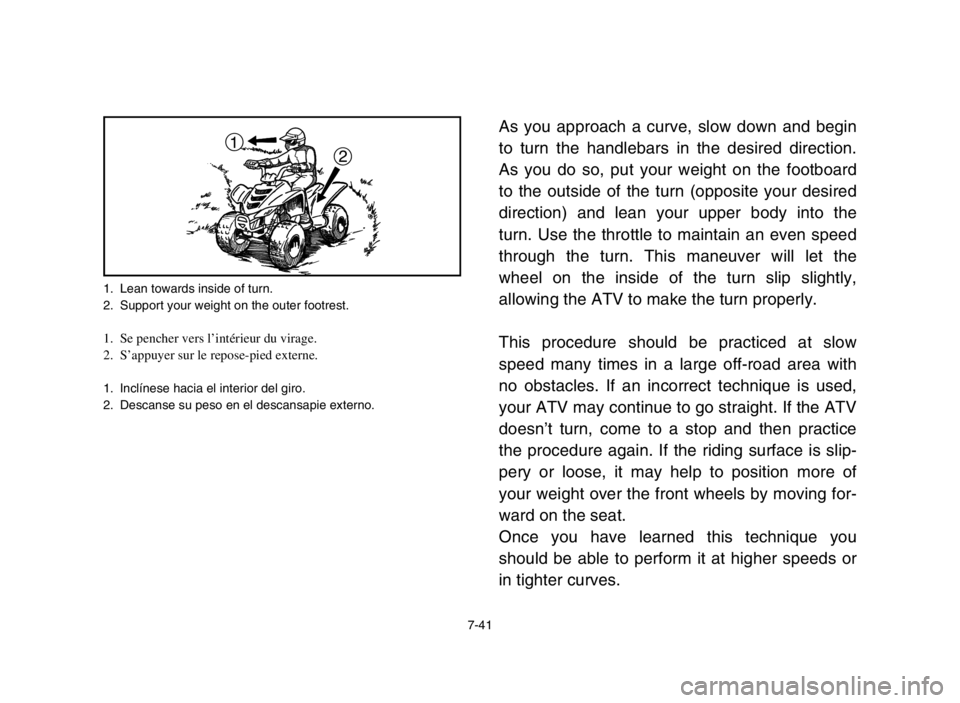
1. Lean towards inside of turn.
2. Support your weight on the outer footrest.
1. Se pencher vers l’intérieur du virage.
2. S’appuyer sur le repose-pied externe.
1. Inclínese hacia el interior del giro.
2. Descanse su peso en el descansapie externo.
7-41
As you approach a curve, slow down and begin
to turn the handlebars in the desired direction.
As you do so, put your weight on the footboard
to the outside of the turn (opposite your desired
direction) and lean your upper body into the
turn. Use the throttle to maintain an even speed
through the turn. This maneuver will let the
wheel on the inside of the turn slip slightly,
allowing the ATV to make the turn properly.
This procedure should be practiced at slow
speed many times in a large off-road area with
no obstacles. If an incorrect technique is used,
your ATV may continue to go straight. If the ATV
doesn’t turn, come to a stop and then practice
the procedure again. If the riding surface is slip-
pery or loose, it may help to position more of
your weight over the front wheels by moving for-
ward on the seat.
Once you have learned this technique you
should be able to perform it at higher speeds or
in tighter curves.1
2
5YF-9-60 7 4/24/03 6:35 PM Page 184
Page 218 of 350

7-51
If your ATV has stalled or stopped and you
believe you can continue up the hill, restart care-
fully to make sure you do not lift the front wheels
which could cause you to lose control. If you are
unable to continue up the hill, dismount the ATV
on the uphill side. Physically turn the ATV
around and then descend the hill.
If you start to roll backwards, DO NOT use the
rear brake to stop or try to put the ATV in gear.
The ATV could easily tip over backwards.
Instead, apply the front brake gradually, or dis-
mount the ATV immediately on the uphill side.
5YF-9-60 7 4/24/03 6:35 PM Page 194
Page 226 of 350

7-59
CROSSING A SLOPE
Traversing a sloping surface on your ATV
requires you to properly position your weight to
maintain proper balance. Be sure that you have
learned the basic riding skills on flat ground
before attempting to cross a sloping surface.
Avoid slopes with slippery surfaces or rough ter-
rain that may upset your balance.
As you travel across a slope, lean your body in
the uphill direction. It may be necessary to cor-
rect the steering when riding on loose surfaces
by pointing the front wheels slightly uphill. When
riding on slopes be sure not to make sharp turns
either up or down hill.
5YF-9-60 7 4/24/03 6:35 PM Page 202
Page 236 of 350
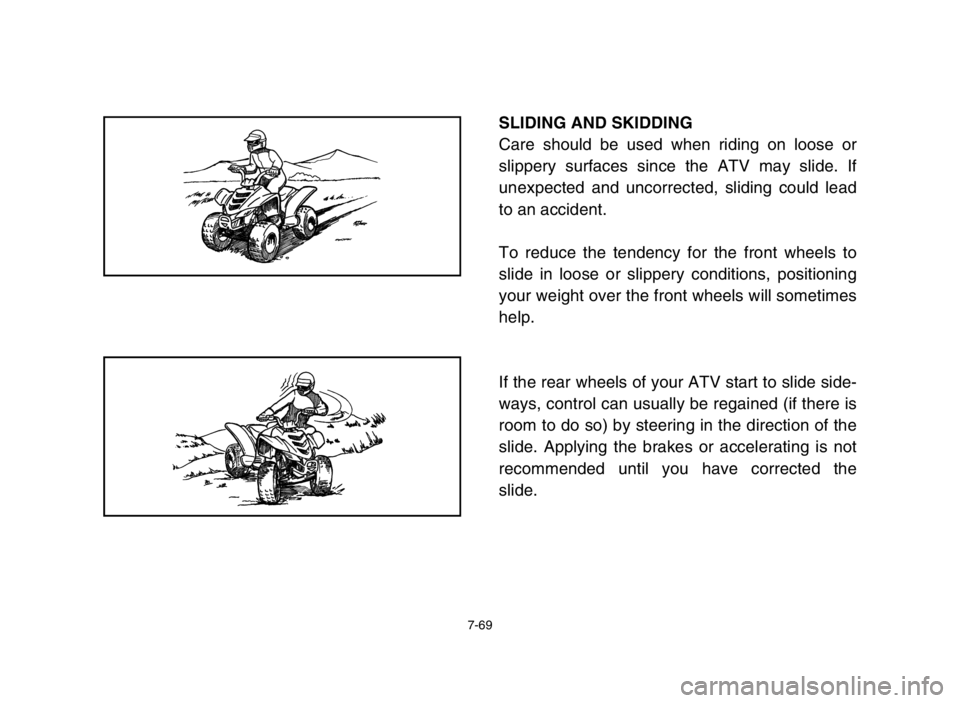
7-69
SLIDING AND SKIDDING
Care should be used when riding on loose or
slippery surfaces since the ATV may slide. If
unexpected and uncorrected, sliding could lead
to an accident.
To reduce the tendency for the front wheels to
slide in loose or slippery conditions, positioning
your weight over the front wheels will sometimes
help.
If the rear wheels of your ATV start to slide side-
ways, control can usually be regained (if there is
room to do so) by steering in the direction of the
slide. Applying the brakes or accelerating is not
recommended until you have corrected the
slide.
5YF-9-60 7 4/24/03 6:35 PM Page 212
Page 240 of 350

7-73
WHAT TO DO IF ...
This section is designed to be a reference guide
only. Be sure to read each section on riding
techniques completely.
WHAT TO DO ...
8If your ATV doesn’t turn when you want it to:
Bring the ATV to a stop and practice the turn-
ing maneuvers again. Be sure you are putting
your weight on the footboard to the outside of
the turn. Position your weight over the front
wheels for better control. (See pages 7-39–
7-43.)
8If your ATV begins to tip while turning:
Lean more into the turn to regain balance. If
necessary, gradually let off the throttle and/or
steer to the outside of the turn. (See pages
7-39–7-43.)
5YF-9-60 7 4/24/03 6:35 PM Page 216
Page 253 of 350

8-8 * Since these items require special tools, data and technical skills, hava a Yamaha dealer perform the service.INITIAL EVERY
ITEM ROUTINE 1 3 6 6 1
month months months months year
Wheels*9Check balance/damage/runout.
2222
9Replace if necessary.
9Check bearing assemblies for looseness/
Wheel bearings*damage.2222
9Replace if damaged.
9Check operation.
Steering system*9Replace if damage.
22222
9Check toe-in
9Adjust if necessary.
Knuckle shafts/9Lubricate every 6 months with Lithium-soap-based
222
steering shaft*grease.
Fittings and fasteners*9Check all chassis fittings and fasteners.
22222
9Correct if necessary.
9Check specific gravity.
Battery*9Check breather hose for correct routing.22222
9Correct if necessary.
5YF-9-60 8 4/24/03 6:35 PM Page 8-8
Page 292 of 350
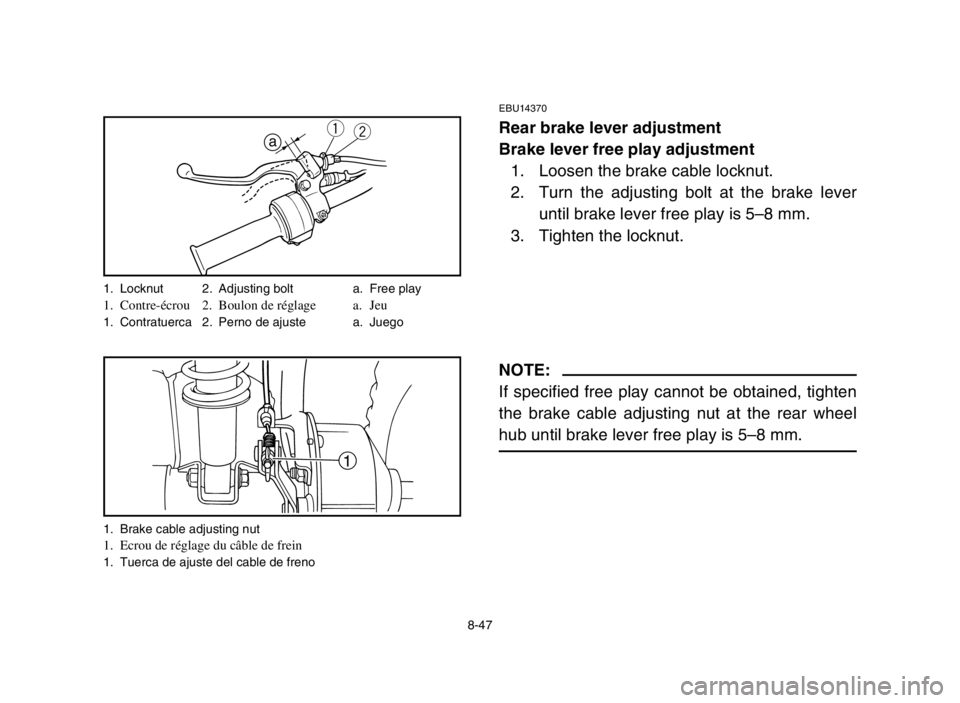
8-47
EBU14370
Rear brake lever adjustment
Brake lever free play adjustment
1. Loosen the brake cable locknut.
2. Turn the adjusting bolt at the brake lever
until brake lever free play is 5–8 mm.
3. Tighten the locknut.
NOTE:
If specified free play cannot be obtained, tighten
the brake cable adjusting nut at the rear wheel
hub until brake lever free play is 5–8 mm.
wqa
1
1. Locknut 2. Adjusting bolt1. Contre-écrou 2. Boulon de réglage1. Contratuerca 2. Perno de ajustea. Free playa. Jeua. Juego
1. Brake cable adjusting nut
1. Ecrou de réglage du câble de frein1. Tuerca de ajuste del cable de freno
5YF-9-60 8 4/24/03 6:35 PM Page 8-47
Page 300 of 350
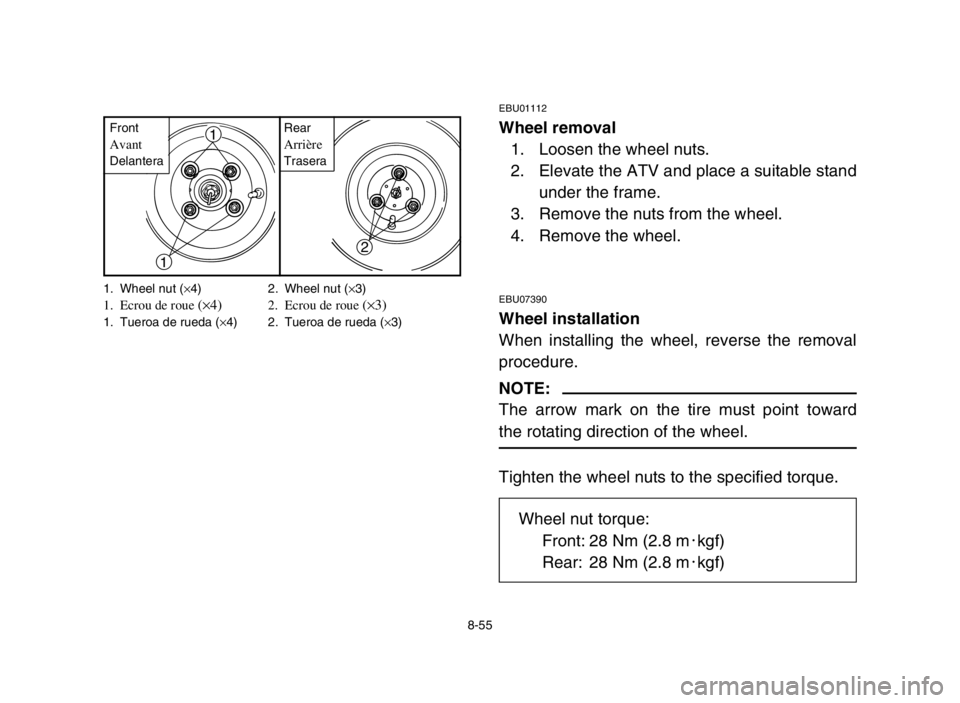
1. Wheel nut (×4) 2. Wheel nut (×3)1. Ecrou de roue (×4)2. Ecrou de roue (×3)1. Tueroa de rueda (×4) 2. Tueroa de rueda (×3)
8-55
EBU01112
Wheel removal
1. Loosen the wheel nuts.
2. Elevate the ATV and place a suitable stand
under the frame.
3. Remove the nuts from the wheel.
4. Remove the wheel.
EBU07390
Wheel installation
When installing the wheel, reverse the removal
procedure.
NOTE:
The arrow mark on the tire must point toward
the rotating direction of the wheel.
Tighten the wheel nuts to the specified torque.
Wheel nut torque:
Front: 28 Nm (2.8 m0kgf)
Rear: 28 Nm (2.8 m0kgf)
1
12
FrontAvantDelantera
RearArrièreTrasera
5YF-9-60 8 4/24/03 6:35 PM Page 8-55
Page 320 of 350

9-1
EBU00420
CLEANING AND STORAGE
A. CLEANING
Frequent, thorough cleaning of your machine
will not only enhance its appearance but will
improve its general performance and extend the
useful life of many components.
1. Before cleaning the machine:
a. Block off the end of the exhaust pipe to
prevent water entry. A plastic bag and
strong rubber band may be used.
b. Make sure the spark plug and all filler caps
are properly installed.
2. If the engine case is excessively greasy,
apply degreaser with a paint brush. Do not
apply degreaser to the wheel axles.
5YF-9-60 9~ 4/24/03 6:34 PM Page 298
Page 322 of 350
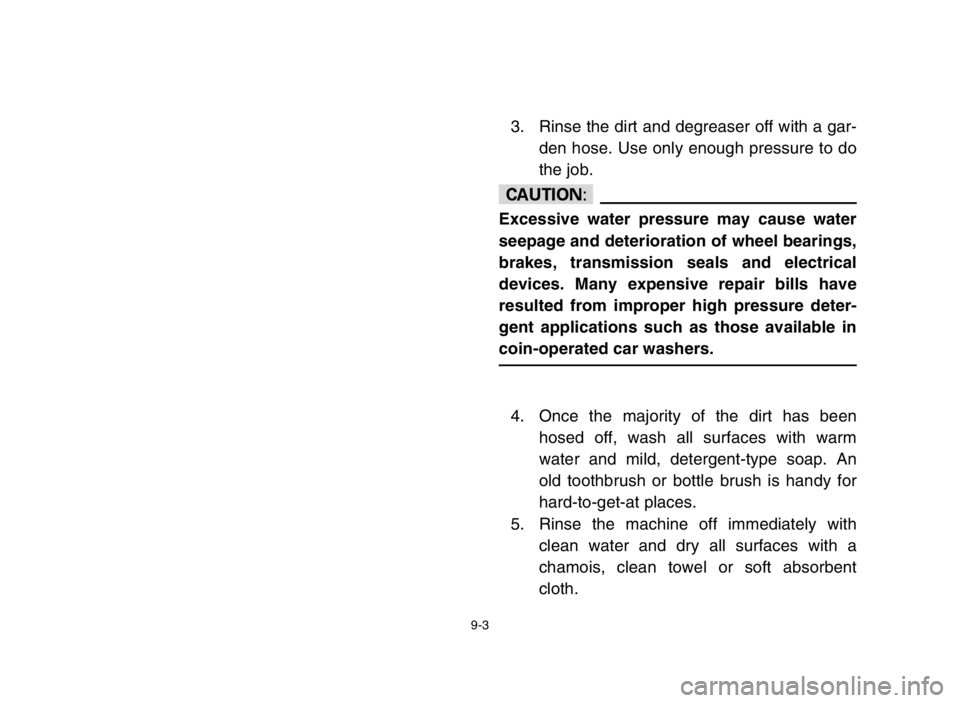
9-3
3. Rinse the dirt and degreaser off with a gar-
den hose. Use only enough pressure to do
the job.
cC
Excessive water pressure may cause water
seepage and deterioration of wheel bearings,
brakes, transmission seals and electrical
devices. Many expensive repair bills have
resulted from improper high pressure deter-
gent applications such as those available in
coin-operated car washers.
4. Once the majority of the dirt has been
hosed off, wash all surfaces with warm
water and mild, detergent-type soap. An
old toothbrush or bottle brush is handy for
hard-to-get-at places.
5. Rinse the machine off immediately with
clean water and dry all surfaces with a
chamois, clean towel or soft absorbent
cloth.
5YF-9-60 9~ 4/24/03 6:34 PM Page 300